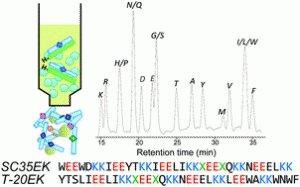This month sees the following articles in MedChemComm that are in the top ten most accessed:-
Discovery of the highly potent PI3K/mTOR dual inhibitor PF-04691502 through structure based drug design
Hengmiao Cheng, Shubha Bagrodia, Simon Bailey, Martin Edwards, Jacqui Hoffman, Qiyue Hu, Robert Kania, Daniel R. Knighton, Matthew A. Marx, Sacha Ninkovic, Shaoxian Sun and Eric Zhang
Med. Chem. Commun., 2010, 1, 139 – 144, DOI: 10.1039/c0md00072h, Concise Article
Silver nanoparticles-the real “silver bullet” in clinical medicine?
Kenneth K. Y. Wong and Xuelai Liu
Med. Chem. Commun., 2010, 1, 125 – 131, DOI: 10.1039/c0md00069h, Review article
Targeting epigenetic modifiers: Inhibitors of histone methyltransferases
Elisabeth-Maria Bissinger, Ralf Heinke, Wolfgang Sippl and Manfred Jung
Med. Chem. Commun., 2010, 1, 114 – 124, DOI: 10.1039/c0md00062k, Review article
Small molecule modulation of stem cells in regenerative medicine: recent applications and future direction
Timothy E. Allsopp, Mark E. Bunnage and Paul V. Fish
Med. Chem. Commun., 2010, 1, 16 – 29, DOI: 10.1039/c0md00055h, Review article
Syntheses and biological evaluation of new cephalosporin-oxazolidinone conjugates
Shanshan Yan, Marvin J. Miller, Timothy A. Wencewicz and Ute Mollmann
Med. Chem. Commun., 2010, 1, 145 – 148, DOI: 10.1039/c0md00015a, Concise article
Chemical space as a source for new drugs
Jean-Louis Reymond, Ruud van Deursen, Lorenz C. Blum and Lars Ruddigkeit
Med. Chem. Commun., 2010, 1, 30 – 38, DOI: 10.1039/c0md00020e, Review article
Cytotoxic sugar analogues of an optimized novobiocin scaffold
Alison C. Donnelly, Huiping Zhao, Bhaskar Reddy Kusuma and Brian S. J. Blagg
Med. Chem. Commun., 2010, 1, 165 – 170, DOI: 10.1039/c0md00063a, Concise article
Photografted poly(methyl methacrylate)-based high performance protein microarray for hepatitis B virus biomarker detection in human serum
Yingshuai Liu, Weihua Hu, Zhisong Lu and Chang Ming Li Med. Chem. Commun., 2010, 1, 132 – 135, DOI: 10.1039/c0md00032a, Concise article
Synthesis and biological evaluation of substituted alpha- and beta-2,3-dihydrofuran naphthoquinones as potent anticandidal agents
Cristina Pessoa Veloso Freire, Sabrina Baptista Ferreira, Nivea Suely Melo de Oliveira, Ani Beatriz Jackisch Matsuura, Ivson Lelis Gama, Fernando de C. da Silva, Maria Cecília B. V. de Souza, Emerson Silva Lima and Vitor Francisco Ferreira
Med. Chem. Commun., 2010, 1, 229 – 232, DOI: 10.1039/c0md00074d, Concise article
Synthesis, modeling, and crystallographic study of 3,4-disubstituted-1,2,5-oxadiazoles and evaluation of their ability to decrease STAT3 activity
Dae-Seop Shin, Daniela Masciocchi, Arianna Gelain, Stefania Villa, Daniela Barlocco, Fiorella Meneghetti, Alessandro Pedretti, Young-Min Han, Dong Cho Han, Byoung-Mog Kwon, Laura Legnani and Lucio Toma
Med. Chem. Commun., 2010, 1, 156 – 164, DOI: 10.1039/c0md00057d, Concise article
Why not take a look at the articles today and blog your thoughts and comments below.
Fancy submitting an article to MedChemComm? Then why not submit to us today or alternatively email us your suggestions.











 Mark Bunnage is executive director of worldwide medicinal chemistry at Pfizer in Sandwich, UK. His areas of responsibility include chemistry leadership for regenerative medicine. He is also a member of the Executive Committee of the European Federation for Medicinal Chemistry (EFMC) and an editorial board member for MedChemComm.
Mark Bunnage is executive director of worldwide medicinal chemistry at Pfizer in Sandwich, UK. His areas of responsibility include chemistry leadership for regenerative medicine. He is also a member of the Executive Committee of the European Federation for Medicinal Chemistry (EFMC) and an editorial board member for MedChemComm. 
